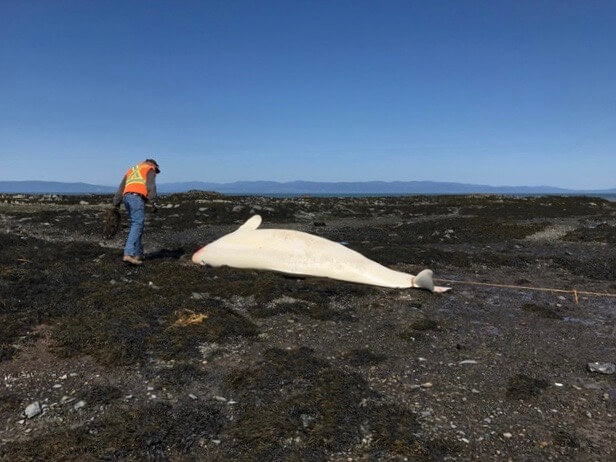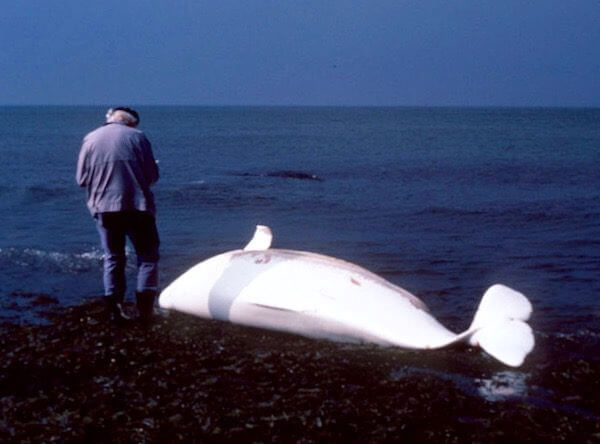Follow the stages of a beluga carcass recovery, from the initial report to the trip to the Faculty of Veterinary Medicine of Université de Montréal.
(1/3) From the sea to the necropsy room
An experienced birder, based in Rivière-Ouelle in the Bas-Saint-Laurent region, scans the waters of the St. Lawrence. Rather than a bird, it’s a white, featherless round mass that attracts his eye, in the centre of which is a pectoral fin pointing skyward. In the middle of the St. Lawrence Estuary, a beluga carcass is drifting with the falling tide in the direction of Kamouraska. He follows it with his spotting scope for three hours before losing sight of it. And so began, on the morning of September 19, the 19th case this year for Marine Mammal Emergencies of a St. Lawrence beluga carcass.
The following day, in under an hour, nearly a dozen calls were received to report a white whale lying on the flat rocks of Baie Saint-Denis, near where the municipalities of Rivière-Ouelle and Saint-Denis-de-la-Bouteillerie meet. A photo taken by a citizen seals the deal: it’s indeed a beluga, probably the same one that was seen adrift yesterday. The response plan is initiated.
Every carcass represents a goldmine of information, a sort of indicator of the health status of this endangered population, which has been studied since the 1970s. It was the live belugas plying the waters around Tadoussac that were of initial interest to scientists, but a carcass found in 1982 on the shores of Rimouski immediately fascinated biologist Pierre Béland and veterinarian Daniel Martineau. “Let’s open ‘er up!” exclaimed Dr. Martineau at the time. And thus began the era of the carcass study project, which continues to this day, making it the longest-running program to monitor the health of a wild population.
Act quickly, no matter what
What follows is a race against the clock; the carcass must be prevented from being carried out to sea again by the tide. Thanks to the collaboration of the municipality of Rivière-Ouelle, the beluga is attached to a rock by its tail. We won’t be letting this one slip away!
It is the volunteers’ turn to go to the site to “document” the situation: measurements; detailed photos of the body, head, deep and superficial markings, and genital slits to determine the sex; indices of the degree of decomposition of the carcass, and an assessment of the environment in which it is found.
The latter aspect is essential for Carl Guimont, who oversees the beluga carcass recoveries. Belugas, even if they are considered small whales, can tip the scales at about two tonnes! Heavy machinery must be able to access the site to lift the whale, lay it on a trailer and drive it to the Faculty of Veterinary Medicine (FMV) at the Université de Montréal. Sometimes this requires overcoming complex logistics, not to mention persistence and patience in order to recover the carcass, which is often found in rocky terrain, on a soft substrate, or even amongst endangered plants, which by law must not be trampled. Thanks to the collaboration of the municipality of Saint-Denis-de-la Bouteillerie, the 3.5 metre long, 1-tonne animal was hauled down Route 132 before finishing its journey in the walk-in refrigerator of the FMV necropsy lab.







